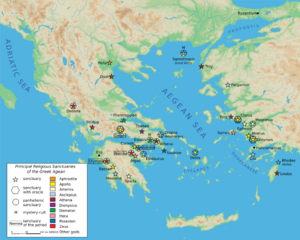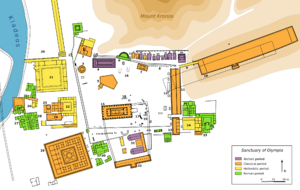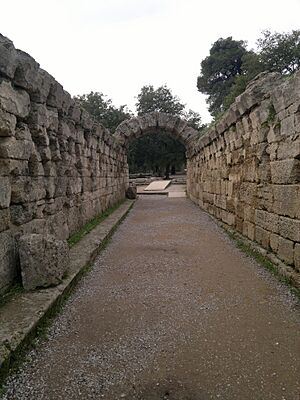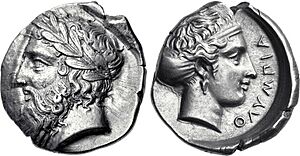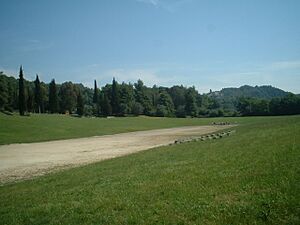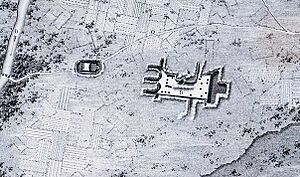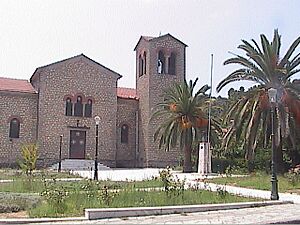Olympia, Greece facts for kids
Quick facts for kids
Olympia
Ολυμπία
|
|
|---|---|

View of the Palestra, a center for wrestling
|
|
| Country | Greece |
| Administrative region | Western Greece |
| Regional unit | Elis |
| Area | |
| • Municipality | 545.1 km2 (210.5 sq mi) |
| • Municipal unit | 178.9 km2 (69.1 sq mi) |
| Elevation | 60 m (200 ft) |
| Population
(2021)
|
|
| • Municipality | 11,153 |
| • Municipality density | 20.4605/km2 (52.992/sq mi) |
| • Municipal unit | 6,859 |
| • Municipal unit density | 38.340/km2 (99.30/sq mi) |
| Community | |
| • Population | 882 (2021) |
| Time zone | UTC+2 (EET) |
| • Summer (DST) | UTC+3 (EEST) |
| Postal code |
2708 25
|
| Area code(s) | 26240 |
| UNESCO World Heritage Site | |
| Official name | Archaeological Site of Olympia |
| Criteria | Cultural: i, ii, iii, iv, vi |
| Inscription | 1989 (13th Session) |
| Area | 105.6 ha |
| Buffer zone | 1,458.18 ha |
Olympia, officially called Archaia Olympia, is a small town in Elis, Greece. It's located on the Peloponnese peninsula. Olympia is famous for its nearby ancient ruins. This site was a very important religious place in ancient Greece. It was where the ancient Olympic Games were held every four years for over a thousand years! The games were brought back to life in 1894 to celebrate friendly international competition.
The special sacred area was called the Altis. It was mainly dedicated to Zeus, the king of the gods. Many other gods were also worshipped there. The games held in Zeus's honor attracted visitors from all over the Greek world. These "Panhellenic" centers helped ancient Greeks feel like one nation. Even though it's called Olympia, it's not near Mount Olympus. That's where the Twelve Olympians, the main Greek gods, were believed to live.
Ancient stories say that other villages, Pisa and Elis, fought with Olympia to control this sacred area. Olympia won, which means the village and the sacred site were not exactly the same place. The modern village of Olympia is thought to be where the ancient village once stood. People have lived there continuously since ancient times.
The archaeological site once had over 760 important buildings. Many ruins still stand today. One special place for Greeks was the Pelopion. This was believed to be the tomb of Pelops, a legendary king. The Peloponnese peninsula is named after him.
Another important spot for both ancient and modern people is the stadium. It's basically a long field with start and finish lines marked by stone curbs. Athletes entered through an arched hallway. Spectators usually sat on the grassy slopes around the field. The length of this field became a standard unit of distance called a "stadion." Today, the stadium has been used again for Olympic events, keeping its original shape. Temporary seats can be set up easily.
The first major games in the Olympia stadium are said to have started in the 720s BC. These famous ancient games took place during the festival of Zeus. Olympia was a sanctuary, but it was part of the independent state of Elis. Since the people of Elis managed the games, there was sometimes unfairness. The famous Olympic truce only guaranteed safe travel for visitors. It didn't stop all wars in Greece.
The modern village helps visitors to the ancient site. The Kladeos River forms the western edge of the site. Visitors cross a bridge to reach the main entrance. Exploring the whole site involves a lot of walking. Archaeologists often work there, digging and finding new things. Most of the smaller artifacts found are kept in one of the site's three museums.
Contents
Exploring the Ancient Site
What Olympia Looked Like
Olympia is in the valley of the Alfeiós River in western Peloponnese. Today, it's about 18 kilometers (11 miles) from the Ionian Sea. In ancient times, it might have been closer to the coast.
According to the ancient writer Pausanias, there were over 70 temples here. There were also treasuries, altars, statues, and other buildings for many gods. Unlike Delphi, where buildings were packed together, Olympia spread out. It went beyond its main sacred wall, especially in the areas used for the games.
North of the main sacred area were the Prytaneion and the Philippeion. There were also many treasuries built by different city-states. The Metroon was south of these treasuries. The Echo Stoa was to the east. The hippodrome (for horse races) and the later stadium were east of the Echo Stoa. South of the sacred area were the South Stoa and the bouleuterion (council house). To the west were the palaestra (wrestling school), the workshop of Pheidias, the gymnasion, and the Leonidaion (a guesthouse).
Olympia was also famous for the giant statue of Zeus. This statue was made of ivory and gold over a wooden frame. It was sculpted by Pheidias and was one of the Seven Wonders of the Ancient World. Close to the Temple of Zeus, where the statue stood, Pheidias's workshop was found in the 1950s. Tools found there helped confirm this was his studio. The ancient ruins are north of the Alpheios River and south of Mount Kronos. The Kladeos River borders the site to the west.
The Altis: A Sacred Grove
The Altis was a special sacred area, shaped like a rectangle. It was more than 183 meters (200 yards) on each side. It had walls on three sides, but not to the north, where Mount Kronos bordered it. This area contained important buildings like the Temple of Hera and the Temple of Zeus. It also had open spaces for traditional activities, such as the large altar of Zeus, where the biggest sacrifices were made.
The poet Pindar from the 5th century BC wrote that Heracles created this "sacred precinct" for Zeus. He called it the Altis. Heracles made it a place for feasts and honored the river Alfeios and the 12 Olympian gods. He also named the nearby hill "Hill of Cronus" and started the Olympic games.
Today, trees like the "Judas-tree" and olive trees grow over the site. These trees might have been there in ancient times too. The size of the Altis likely changed as the site grew. The original stadium even extended inside what later became the eastern wall. The wall around the Altis was probably built later, but before Pindar's time.
The Pelopion: A King's Sanctuary
The classical Pelopion was a separate sacred area with its own wall. This wall was built around 600 BC, long after the traditional start of the Olympic games in 776 BC. This was likely a new version of an older sanctuary dedicated to Pelops. Excavations in 1987 found pottery and religious items from as far back as 1100 BC. This shows that the site had been used for religious activities for a very long time.
What's in a Name?
The name Altis comes from an old word from the region of Elis. It means "the grove" because the area used to be covered with trees, especially olive and plane trees.
A Look at Olympia's Past
Early Beginnings
People once thought that Olympia had been settled since about 1500 BC. They believed a religious group worshipping Zeus started around 1000 BC. However, some now think the sanctuary might only date back to the 9th or 8th centuries BC. Still, remains of food and burnt offerings from the 10th century BC suggest a long history of religious activity. No buildings from this very early period have survived.
Geometric and Archaic Periods
The first Olympic festival was organized by the people of Elis in the 8th century BC. Tradition says the first games were in 776 BC. Around 700 BC, big changes were made to the site, like leveling the land and digging new wells. Later, Elis lost control, and the sanctuary was taken over by the Pisatans in 676 BC. They managed the games until the late 7th century BC.
The oldest signs of building activity are from around 600 BC. At this time, the Skiloudians, who were allies of the Pisatans, built the Temple of Hera. The Treasuries and the Pelopion were built during the 6th century BC. Other buildings and athletic areas, including the Bouleuterion, were also under construction. The first stadium was built around 560 BC. It was just a simple track. Around 500 BC, the stadium was changed with sloping sides for spectators and moved slightly to the east. More sports were added to the Olympic festival during the 6th century BC. In 580 BC, Elis, with help from Sparta, took back control of the sanctuary.
The Golden Age of Olympia
The Classical period, from the 5th to 4th centuries BC, was Olympia's golden age. Many new religious and everyday buildings were constructed.
The Temple of Zeus was built in the mid-5th century BC. It was much larger and grander than anything built before it. New facilities for sports, like the final version of the stadium and the hippodrome (for chariot races), were also built. The Prytaneion was built in 470 BC.
Later in the Classical period, more structures were added. The Metroon was built near the Treasuries around 400 BC. The Echo Stoa, built around 350 BC, created a separation between the sacred area and the sports fields. The South Stoa was built at the southern edge of the sanctuary around the same time.
Hellenistic Period Changes
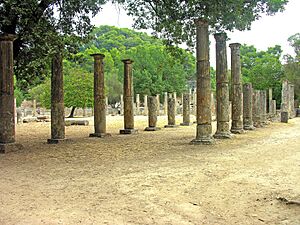
The late 4th century BC saw the building of the Philippeion. Around 300 BC, the largest building on the site, the Leonidaion, was built to house important visitors. As the games became more important, more athletic buildings were added. These included the Palaestra (a wrestling school from the 3rd century BC), the Gymnasion (from the 2nd century BC), and bath houses (around 300 BC). Finally, in 200 BC, a vaulted archway was built. It connected the stadium entrance to the sacred area.
Roman Times and Decline
During the Roman period, the games were opened to all citizens of the Roman Empire. Many new buildings were added, and older ones, like the Temple of Zeus, were repaired. In 150 AD, the Nympheum (a fountain house) was built. New baths replaced the older Greek ones around 100 AD, and an aqueduct was built in 160 AD.
In the 3rd century AD, earthquakes caused a lot of damage to the site. Invading tribes in 267 AD fortified the center of the site using materials taken from its monuments. Despite the destruction, the Olympic festival continued until the last games in 393 AD. After this, the Christian emperor Theodosius I banned pagan festivals. The Temple of Zeus was likely destroyed around 426 AD. This happened during the time when pagan religions were being suppressed. Pheidias's workshop was turned into a church, and a Christian community lived on the site. Small Olympic events might have continued secretly until a plague and two earthquakes destroyed the area in the mid-6th century. Repeated floods finally led to the site being completely abandoned in the early 7th century.
Archaeological Discoveries
Finding the Lost Site
Over time, the site was buried under layers of dirt and mud, up to 8 meters (26 feet) deep. For a long time, people thought this was caused by river floods. However, modern research suggests it might have been from repeated tsunamis from the sea. The exact location of Olympia was found again in 1766 by an English historian named Richard Chandler. After that, several other travelers visited the site.
The first official excavation happened in 1829. French archaeologists from the "Expedition Scientifique de Morée" arrived at Olympia. Most of the buildings were hidden, but they used old descriptions to figure out what was where. The French archaeologists worked for six weeks. They divided the site into squares, dug trenches, and made plans for how to restore the ruins. This was how the location of the Temple of Zeus was found for the first time.
Since the 1870s, the German Archaeological Institute at Athens has been in charge of digging and preserving Ancient Olympia. The first big German excavation started in 1875. They dug up the central part of the sanctuary, including the Temple of Zeus and the Temple of Hera. Important finds included sculptures from the Temple of Zeus, the Nike statue by Paeonius, and the Hermes statue by Praxiteles. In total, 14,000 objects were found. These discoveries are now shown in a museum at the site.
Archaeological work continued in the 20th century. Between 1952 and 1966, they excavated Pheidias's workshop, the Leonidaion, and the north wall of the stadium. They also found many bronze and ceramic objects. More recently, in March 2021, archaeologists announced the discovery of a 2,500-year-old unbroken bronze bull idol near the temple of Zeus. This bull statue was found after heavy rainfall. Researchers also found fine pottery from Greece's Geometric art period.
Modern Olympia Today
The Town of Olympia
The ancient site has always been part of a community called Olympia. Today, it's known as Archaia Olympia, meaning "Ancient Olympia." In 2011, for government reasons, it was combined with three other towns to form a larger municipality. So, "Ancient Olympia" can mean either the modern town or just the ruins.
The town has a train station. It's the end of the train line from Olympia to Pyrgos (Ilia). The train station is about 300 meters (980 feet) east of the town center. Olympia is connected by GR-74, a road that opened in the 1980s. The area around Olympia is mostly flat farmland, with many olive trees. A reservoir a few kilometers west holds water from the Alfeios River for electricity.
The town and the ancient site of Olympia were almost destroyed by the severe forest fires in 2007.
How Olympia's Population Has Changed
| Year | Community | Municipal unit | Municipality |
|---|---|---|---|
| 1981 | 1,129 | – | – |
| 1991 | 1,742 | 11,229 | – |
| 2001 | 936 | 9,689 | - |
| 2011 | 972 | 8,128 | 13,409 |
| 2021 | 882 | 6,859 | 11,153 |
Famous People from Olympia
Panagiotis Kondylis, a well-known modern Greek thinker and philosopher, was born and grew up in Olympia.
When Pierre de Coubertin, who started the modern International Olympic Committee, died in 1937, a monument was built for him at ancient Olympia. His heart was buried there, just like Evangelis Zappas, whose head is buried under a statue in front of the Zappeion.
Bringing the Games Back
After the ancient Olympic Games were stopped in 394 AD, the idea of peaceful international competition continued. The games were brought back in 1894, based on the ancient model, but now even more international. The spirit of the new games looked to ancient Olympia for inspiration. Even the ruins became a symbol. The Olympic flame for the modern Olympic Games is lit by sunlight reflected in a special mirror. This happens in front of the Temple of Hera. Then, the flame is carried by a torch to the place where the games are held. When the modern Olympic Games came to Athens in 2004, the men's and women's shot put event was held at the restored Olympia stadium.
Buildings and monuments from Olympia have often been featured on collector's coins. For example, a €100 Greek coin was minted in 2003 to celebrate the 2004 Summer Olympics. On this coin, you can see the Crypt of Olympia. The crypt is a long, arched passage where athletes and judges entered the stadium. It symbolizes the start of the games.
Images for kids
See also
 In Spanish: Olimpia para niños
In Spanish: Olimpia para niños
- List of settlements in Elis
- Archaeological Museum of Olympia
- German Archaeological Institute at Athens
- Museum of Ancient Greek Technology in Katakolo




